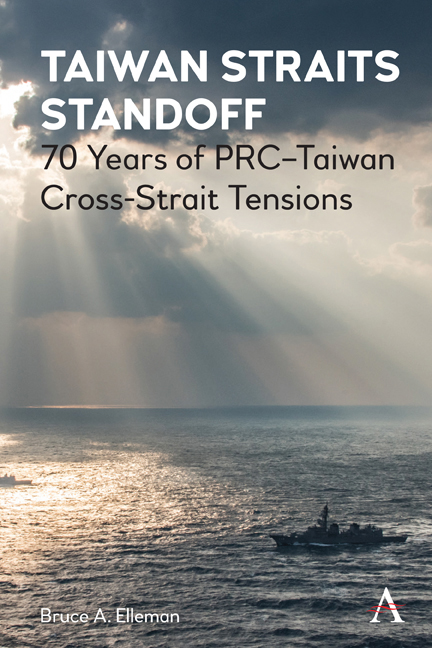Book contents
- Frontmatter
- Dedication
- Contents
- List of Illustrations
- Introduction: Stalemate along the Taiwan Straits, 1949–2020
- 1 The Two Chinas and the Battle for Control of Offshore Islands
- 2 President Harry S. Truman’s Decision to Protect Taiwan
- 3 The First Taiwan Strait Crisis, 1954–55
- 4 The Evacuation of the Dachen Islands, 1955
- 5 The Second Taiwan Strait Crisis, 1958
- 6 The US Threat to Use Atomic Weapons
- 7 Using Taiwan to Undermine the Sino-Soviet Alliance
- 8 Taiwan during the Cold War and Afterward
- Conclusions: The Taiwan Strait’s Strategic Significance Today
- Appendix: Naval Terms and Acronym List
- Selected Bibliography
- Index
4 - The Evacuation of the Dachen Islands, 1955
- Frontmatter
- Dedication
- Contents
- List of Illustrations
- Introduction: Stalemate along the Taiwan Straits, 1949–2020
- 1 The Two Chinas and the Battle for Control of Offshore Islands
- 2 President Harry S. Truman’s Decision to Protect Taiwan
- 3 The First Taiwan Strait Crisis, 1954–55
- 4 The Evacuation of the Dachen Islands, 1955
- 5 The Second Taiwan Strait Crisis, 1958
- 6 The US Threat to Use Atomic Weapons
- 7 Using Taiwan to Undermine the Sino-Soviet Alliance
- 8 Taiwan during the Cold War and Afterward
- Conclusions: The Taiwan Strait’s Strategic Significance Today
- Appendix: Naval Terms and Acronym List
- Selected Bibliography
- Index
Summary
The February 8–11, 1955, evacuation of the Dachens was a massive undertaking. The USN used a total of 132 ships and 400 aircraft to evacuate 14,500 civilians, 10,000 Nationalist troops, and approximately 4,000 guerrilla fighters, along with over 40,000 tons of military equipment and supplies. To protect the evacuation, the Seventh Fleet assembled a “backbone” of six aircraft carriers. China was warned not to interfere. USN forces “have instructions not to provoke incidents but they also have instructions not to accept any tactical disadvantages.” Or, put another way, “American airmen were not to get ‘altruistically shot down’.”
The international reaction to the Dachen evacuation was mixed. To the Australians, the loss of the Dachens was compared to the 1938 fall of Czechoslovakia, while the PRC threat to invade Taiwan was compared to the 1939 invasion of Poland. In a February 1955 Gallup poll, 66 percent of Australians “declared themselves in favour of Australia joining the United States in any war which might result from United States efforts to prevent Chinese Communists from invading Formosa.” In a letter from April 1955, Australian Prime Minister Menzies advocated the “desirability of giving Formosa military and political strength to ensure the future will be decided peacefully and not as a result of Communist policies of force.”
What follows is a summary of the Army History entitled “Evacuation of the Tachen Islands.” This final corrected copy dates to May 19, 1956. While protecting the Dachen evacuation was up to the USN, the US Army was put in charge of the actual evacuation of civilians, guerrillas, and military personnel, plus destroying anything of value. It was a mammoth undertaking, as reflected in the name of the operation “Operation King Kong.”
Planning the evacuation of the Dachens
While it is true that the MAAG had sent an advisory team to the Dachens as early as 1953, it had normally consisted of but a single officer. Just prior to the Yichiang landing the total advisory effort on these islands consisted of Colonel Robert L. Walton and a three-man radio team. These personnel were serving a fixed tour on this offshore position after which they were scheduled for rotation to other duties on Taiwan proper.
- Type
- Chapter
- Information
- Taiwan Straits Standoff70 Years of PRC–Taiwan Cross-Strait Tensions, pp. 65 - 86Publisher: Anthem PressFirst published in: 2021



